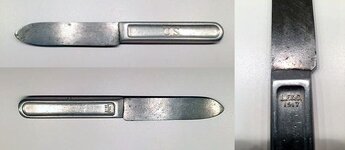watercolor
Silver Member
- Feb 3, 2007
- 4,112
- 1,351
- Detector(s) used
- V3i, MXT-All Pro and Equinox 800
- Primary Interest:
- All Treasure Hunting
Hi everyone!
Last weekend I was hunting the forest across from where a 1920's era
Boy Scout camp once was and found this knife. . . or what's left of it, at about 4".
The handle is cast aluminum and 3-1/2" in length and has "A.C.Co. 1918"
in raised letters on one side. . . the reverse side has no imprinting at all.
Could this be a WWI "U.S. Army" issue utility knife even though it has no markings as such?


Thanks for any of your thoughts,
watercolor
Last weekend I was hunting the forest across from where a 1920's era
Boy Scout camp once was and found this knife. . . or what's left of it, at about 4".
The handle is cast aluminum and 3-1/2" in length and has "A.C.Co. 1918"
in raised letters on one side. . . the reverse side has no imprinting at all.
Could this be a WWI "U.S. Army" issue utility knife even though it has no markings as such?


Thanks for any of your thoughts,
watercolor



 )
)





